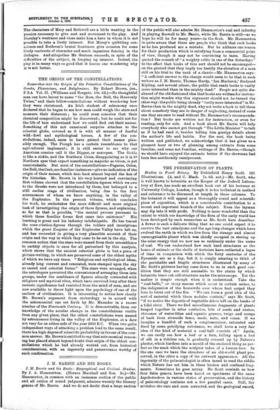THE ORIGIN OF THE CONSTELLATIONS.
Researches into the Origin of the Primitive Constellations of the Greeks, Phcenicians, and Babylonians. By Robert Brown, jun., F.S.A Vol. II. (Williams and Norgate. 10s. 6d.)—No thoughtful man can have learnt to name "the Ram, the Bull, the Heavenly Twins," and their fellow-constellations without wondering how they were christened. An Irish student of astronomy once declared that he began to see how men could weigh the stars and measure their distances ; he could even conceive that their chemical composition might be discovered ; but he could not for the life of him understand how we could find out their names. Something of this not unnatural surprise attaches to the celestial globe, covered as it is with all manner of fearful wild - fowl and mythological heroes. A few of the con- stellations, indeed, seem to have gained their names plau- sibly enough. The Plough has a certain resemblance to that agrbultural implement ; it is still easier to see why our American cousins call it the Dipper, or saucepan. The Sickle is like a sickle, and the Southern Cross, disappointing as it is to Northern eyes that expect something as majestic as Orion, is yet unmistakable. But most of the constellations—Pegasus, Orion, the Bull, the Crab, are familiar instances—give no indication of the origin of their names, which date back almost beyond the ken of the historian. Mr. Brown in his vety learned and convincing first volume showed that the constellation-figures which we owe to the Greeks were not introduced by them, but belonged to a still earlier stage of civilisation, being due to the first astronomers of whom we know anything, in the valley of the Euphrates. In the present volume, which concludes his work, he undertakes the more difficult and more original task of investigating the origin of these figures, and explaining, so far as that is possible, "the mental process pursuant to which these familiar forms first came into existence." His learning is great and his industry indefatigable. He has traced the consi ellation-figures through the tablets and inscriptions which the great Empires of the Euphrates Valley have left us, and has succeeded in giving a very plausible account of their origin and the way in which they came to be set in the sky. The common notion that the stars were named from their resemblance to earthly objects is once for all pulverised by this analysis, which shows that the ancient celestial globe is but a piece of picture-writing, in which are preserved some of the oldest myths of which we have any trace. "Religious and mythological ideas, already long current and venerated, were stamped upon the sky as sacred and celestial forms." The stars were arranged, when the astrologers perceived the convenience of arranging them into groups, under the semblance of figures already connected with religious and mystical rites, which have survived long after their esoteric significance had vanished from the mind of man, and are now available to throw light upon the psychology of one of the earliest of civilisations. It is interesting to notice how closely Mr. Brown's argument from archreology is in accord with the astronomical one set forth by Mr. Maunder in a recent number of the Nineteenth Century. It is demonstrable, from our knowledge of the secular change in the constellations visible from any given place, that the oldest constellations were named by astronomers living in the valley of the Euphrates, at a date not very far on either side of the year 2800 B.C. When two quite independent ways of attacking a problem lead to the same result, there is a high degree of scientific probability in favour of the com- mon answer. Mr. Brown is entitled to say that astronomical reason- ing has placed almost beyond doubt that origin of the oldest con- stellations which he had already worked out, from historical considerations, with an ingenuity and perseverance worthy of such confirmation.


















































 Previous page
Previous page